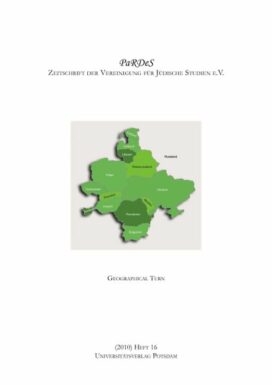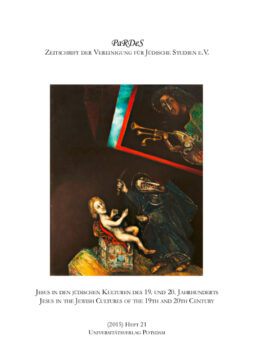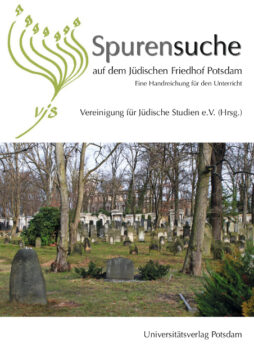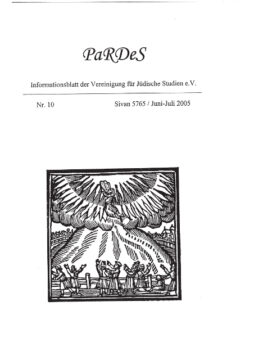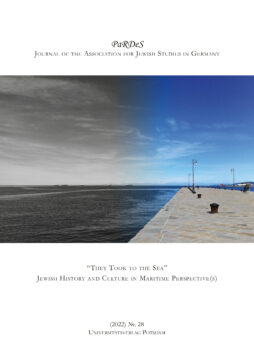Rebekka Denz, Rafael Arnold , Silviu Costachie, Michael Dallapiazza, Anat Feinberg, Elvira Grözinger, Karl Erich Grözinger, William Hiscott, Per Jegebäck, Grazyna Jurewicz, Daniel Jütte, Robert Jütte, Elena Keidosiute, Ulrich Knufinke, Stefan Lang, Joanna Lisek, Diana I. Popescu, Maria Radosav, Ingedore Rüdlin, Anna Rutkowski, Peter Salner, Michael K. Schulz, Suanne Talabardon, Tamas Visi, Kerry Wallach
Rebekka Denz; Grazyna Jurewicz (eds.)
ISBN: 978-3-86956-055-7
265 pages, Paperback
Release year 2010
Series: PaRDeS : Zeitschrift der Vereinigung für Jüdische Studien e.V. , 16
8,00 €
Non-taxable transaction according to § 1 (1) UStG/VAT Act in combination with § 2 (3) UStG/VAT Act a. F. Providing this service, the University of Potsdam does not constitute a Betrieb gewerblicher Art/Commercial Institution according to § 1 (1) No. 6 or § 4 KStG/Corporate Tax Act. If the legal characterization of our business is changed to a commercial institution subsequently, we reserve the right to invoice VAT additionally. zzgl. Versandkosten
Recommended Books
-
 2015
2015Nathanael Riemer, Avidov Lipsker, Michael K. Schulz
Jesus in den Jüdischen Kulturen des 19. und 20. Jahrhunderts = Jesus in the Jewish Cultures of the 19th and 20th Century
15,50 €Non-taxable transaction according to § 1 (1) UStG/VAT Act in combination with § 2 (3) UStG/VAT Act a. F. Providing this service, the University of Potsdam does not constitute a Betrieb gewerblicher Art/Commercial Institution according to § 1 (1) No. 6 or § 4 KStG/Corporate Tax Act. If the legal characterization of our business is changed to a commercial institution subsequently, we reserve the right to invoice VAT additionally.
zzgl. Versandkosten
Add to cart -
 2017
2017Vereinigung für Jüdische Studien e. V. (Hrsg.)
Spurensuche auf dem Jüdischen Friedhof Potsdam
14,50 €Non-taxable transaction according to § 1 (1) UStG/VAT Act in combination with § 2 (3) UStG/VAT Act a. F. Providing this service, the University of Potsdam does not constitute a Betrieb gewerblicher Art/Commercial Institution according to § 1 (1) No. 6 or § 4 KStG/Corporate Tax Act. If the legal characterization of our business is changed to a commercial institution subsequently, we reserve the right to invoice VAT additionally.
zzgl. Versandkosten
Add to cart -
 2005
2005Peter Blastenbrei, Alexander Dubrau, Alfred Einstein, Helga Embacher, Ruvin Ferber, Elvira Grözinger, Karl Erich Grözinger, Tim Hess, Daniel Jütte, Nathanael Riemer, Manfred Voigts
Sivan 5765
2,50 €Non-taxable transaction according to § 1 (1) UStG/VAT Act in combination with § 2 (3) UStG/VAT Act a. F. Providing this service, the University of Potsdam does not constitute a Betrieb gewerblicher Art/Commercial Institution according to § 1 (1) No. 6 or § 4 KStG/Corporate Tax Act. If the legal characterization of our business is changed to a commercial institution subsequently, we reserve the right to invoice VAT additionally.
zzgl. Versandkosten
Add to cart -
 2023
2023Björn Siegel, Markus Krah, Joachim Schlör, Kobi Cohen-Hattab, Oskar Czendze, Franziska Weinmann, Michael Studemund-Halevy, Dalia Wassner, Frank Jacob, Allison Schachter, Sebastian Schirrmeister, Caroline Jessen, Elias Sigmund Jungheim, Saskia Fischer, Jessica Cooperman, Caroline Emig, Shai Ginsburg
“They Took to the Sea”
9,50 €Non-taxable transaction according to § 1 (1) UStG/VAT Act in combination with § 2 (3) UStG/VAT Act a. F. Providing this service, the University of Potsdam does not constitute a Betrieb gewerblicher Art/Commercial Institution according to § 1 (1) No. 6 or § 4 KStG/Corporate Tax Act. If the legal characterization of our business is changed to a commercial institution subsequently, we reserve the right to invoice VAT additionally.
zzgl. Versandkosten
Add to cart
Publisher Info
Contact
Potsdam University Library
University Press
Am Neuen Palais 10
14476 Potsdam
Germany
verlag@uni-potsdam.de
0331 977-2094
0331 977-2292

